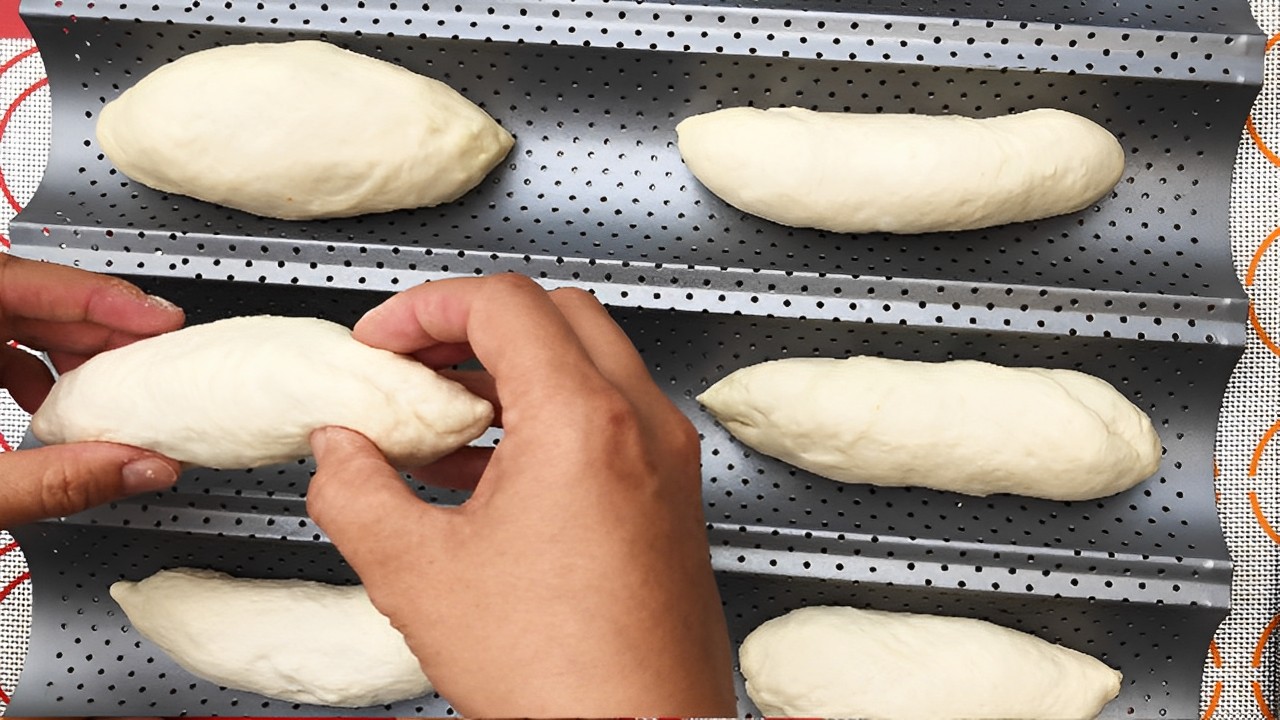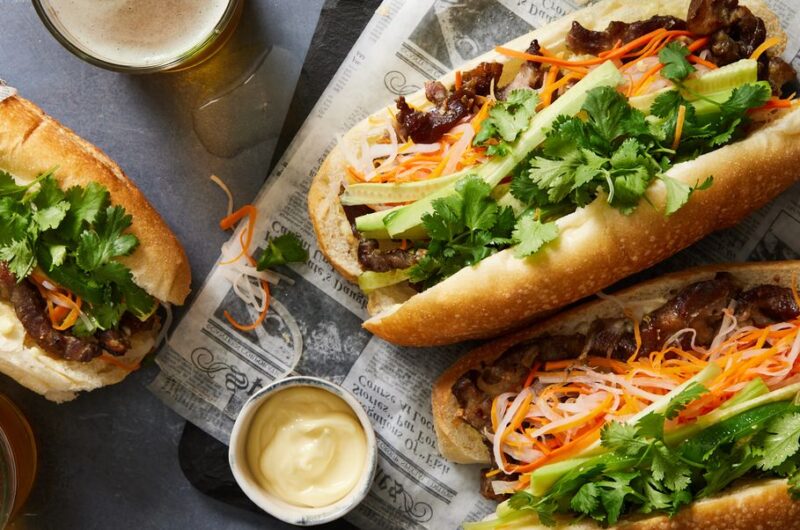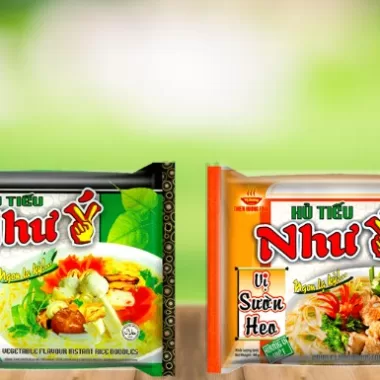How to make banh mi? This is a question that many people are interested in right now. Vietnamese sandwich is a “specialty” of the Vietnamese people because it is cooked with unique fillings. In particular, a Vietnamese sandwich is also known as a daily breakfast dish, fast but still full of nutrients. Tasty Touch will show you how to make banh mi in the oven with just a few simple steps and ingredients through the article below!
What is Vietnamese banh mi?
Vietnamese banh mi is a Vietnamese dish, with the outer layer of a loaf of toast with crispy skin, soft inside, and a filling inside. People can choose from many different fillings depending on their regional culture or personal preference.
However, the traditional type of Vietnamese sandwich usually contains sausages, meat, fish, vegetarian food, or fruit jam, along with some other ingredients such as pate, butter, vegetables, chili, and pickles. Vietnamese sandwiches are considered a popular fast food and are usually consumed for breakfast or any day snack. Because of their reasonable price, Vietnamese sandwiches have become a favorite dish of many people.

Vietnamese banh mi is derived from baguettes, brought to South Vietnam by the French in the 20th century. Some researchers believe that Vietnamese sandwich has been present in Vietnam since 150 years ago. Decades later, Vietnamese sandwiches spread throughout the central and southern regions, especially in Saigon. The inside of the baguette was more hollow to accommodate more fillings, similar to a sandwich. Depending on the ingredients, banh mi has different names. In addition, Vietnamese sandwich is also served with various dishes, such as braised beef, sardines, or shumai.
After 1975, following the migration and crossing of the sea of Vietnamese people, Vietnamese sandwiches became popular in many countries and territories around the world. This dish is available in nearly every country where Vietnamese expatriates live because of its easy-to-find ingredients and simple processing, which is suitable for their culture. Banh mi” becomes banh mi instead of a Vietnamese sandwich like similar dishes. In March 2012, the travel website of The Guardian newspaper voted Vietnamese sandwiches in the top 10 most delicious and attractive street foods in the world.
Vietnamese banh mi has a thin, crispy crust, often with the golden color of baked goods – not too dark, just slightly yellow and slightly cracked. Beneath the crispy crust is a soft and white flesh that can be briefly described as “crunchy with a soft core.” The Vietnamese sandwich is a bit longer than a hand, and slightly tapered at both ends. There are notches on the top of the Vietnamese sandwiches so the dough has room to expand while baking. In addition, Vietnamese sandwiches can also be made from both flour and rice flour.
How to make bánh mì recipe?
The Ultimate and Authentic Vietnamese Banh Mi Recipe
Cuisine: Vietnamese4
servings30
minutes40
minutes300
kcalBelow is a simple but tasty Vietnamese Banh mi recipe. Let’s begin:
Ingredients
Bread flour 500g
Instant yeast 6 gr
Vitamin C powder 0.15 gr
Vinegar 10 gr
Salt 5g
Sugar 8g
Cold water 300 ml
Cooking oil 25 ml
Directions
- Step 1. Prepare the dough
500 grams of bread flour, 6 grams of quick yeast, 8 grams of sugar, 5 grams of salt, and 0.15 grams of vitamin C powder are added to a mixing dish. The dry flour is combined with a flat spatula.
Note: If you’re using fresh yeast or instant yeast (the kind that comes in blocks), you may just stir it right into the flour mixture. When using dried yeast, it must first be activated by soaking it in warm water before being combined with the baking powder.
Then, add 300 ml of cold water, 10 gr of vinegar, 25 ml of cooking oil, and the dry flour combination. Mix thoroughly until the powder has absorbed all the water and has solidified into a mass.
Advice: Split the cold water three times. Each time, add a little amount of water gently into the flour mixture. Once the flour has absorbed all the water, add the cold water. One pour should be avoided as the dough will be readily harmed.
- Step 2. Knead the dough
To prevent the dough from sticking to your hands when kneading it by hand, dust a little flour on the table and massage a little oil into both palms. Then fold the dough and continue pushing and stretching it with the palm of your other hand while you continue to knead it (folding and stretching technique). Hand knead the dough continuously for 15 minutes, or until it is elastic and does not adhere to your hands.
If you’re using a dough mixer, start it at low speed (number 2) for two minutes, then bring the speed up to number 4 and mix for ten minutes. After that, let the dough rest for a minute or so.
Reminder: To give the Vietnamese sandwich a more pliable and chewy texture, start the mixer at a low speed before increasing the speed.
Continue to start the machine at number 4 and mix for roughly 5 minutes after allowing the dough to rest. Finally, raise the level to 6, then blend for another two minutes.
- Step 3. Shape the banh mi
Before beginning to form the banh mi, take the dough out of the mixing bowl and knead it once more until it is smooth. We remove the dough from the bowl once it has rested, split it into little pieces (approximately 10–12g for each tablet), and then equally spread some frying oil over the table and our hands.
To start, remove a block of dough, push down on it with your hands, and then softly tap the dough’s surface to remove air bubbles. Next, fold the dough’s outside edges one at a time, gently compress the edges, and then round. Up until you run out of dough blocks, repeat this.
Note: After rolling the dough, make sure the surface is smooth and glossy to indicate compliance with the standard and a more appealing final product.
The dough should be covered with a dry, clean cloth and let rest for ten minutes. After ten minutes, flip the smooth side down and keep gently pressing and folding the edges while once again rounding them. and then wait another five minutes.
Next, to thin out the dough, remove the rolling pin, position it in the center of the dough, and gently roll it out from top to bottom. You roll broader and thinner at the bottom than at the top. After being rolled, the dough takes on a roughly hand-sized triangular form.
Roll the dough’s 2 ends gently together to form a pointy tip as you start to carefully roll the top down the edge into an elongated shape.
The surface of the Vietnamese sandwich dough dries up extremely rapidly, so try to move as soon as possible while forming the sandwich.
After shaping the bread, place the banh mi on a sheet with tiny ventilation holes and bake for about 15 minutes with the oven covered.
Open the oven to allow air in after 15 minutes, then let the food incubate for a further 5 minutes. Be cautious not to turn on the oven or turn it on before the Vietnamese sandwich is ready to be baked.
- Step 4. Bake the banh mi (first time)
Before baking, stabilize the oven temperature by preheating it to 240 degrees Celsius for 15 minutes. Don’t forget to place an empty baking pan in the oven.
Open the oven top after it has heated up and then pour roughly 300 ml of boiling water onto the baking pan. Pour gently to prevent hand burns.
To produce humidity, prepare a tray of boiling water in the oven to assist establish a temperature on the lower burner.
Once the oven is ready, immediately moisten the surface of the Vietnamese sandwich by spraying water and swiftly cutting a line like a C shape with the tip of a knife or razor down the length of the sandwich, approximately 2 cm from the ends. Pay close attention to where you should spray more – in the incision.
Place the Vietnamese sandwich in the oven and set it over the hot water tray in the center of the oven. Bake the banh mi for 8 minutes with the oven covered at 240 degrees C. Turn the Vietnamese sandwich tray back so that the banh mi on the exterior is also cooked evenly after approximately 8 minutes when you can see that the Vietnamese sandwich is now puffed and golden.
- Step 5: Bake the banh mi (second time)
Bake the second time by lowering the temperature to 200 degrees Celsius and baking for 10 minutes to be evenly golden. Then open the oven for about 1 minute and then close it, bake the 3rd time at a temperature of 180 degrees C for another 2-3 minutes to complete.
Pro tip: You should prepare some extra sesame seeds to spread on the banh mi when it’s cooked. The aroma of sesame and butter will enhance the deliciousness of Vietnamese sandwiches.
- Step 6: Finished bánh mì recipe
The loaves of Vietnamese sandwich swelled and puffed with the characteristic faint scent of banh mi spreading throughout the kitchen. Try tearing a loaf of Vietnamese sandwich and you will hear the crunchy sound of the crust is extremely delicious.
The crust is thin, and golden crispy, and the Vietnamese sandwich inside is chewy, seeing each layer of banh mi is extremely attractive. You can eat Vietnamese sandwiches without or dip it with hot milk or condensed milk, you will love it!
- Step 7: Add filling to make Vietnamese banh mi
The foods used as banh mi fillings vary from region to region, often including the following groups:
Main ingredients from animals: spring rolls, sausages, roast pork, shumai, pork rolls, minced meat stewed with spices, liver pate, sausages, shredded chicken, sardines, cheese, omelet, cold meat, butter, onion fat…
Vegetables: thinly sliced cucumber, coriander (cilantro), pickles (turnips, sweet and sour carrots), scallions, onions, basil, chili…
Seasoning: salt, pepper, soup powder…
Sauce: soy sauce, fish sauce, sauce, chili sauce, mayonnaise…
The above ingredients are presented ready to serve depending on the preferences of the eater. People usually bake a crispy hot Vietnamese sandwich in advance, make a slit along the body of the banh mi and put the seasoning, the main ingredient, and a few vegetables – like cucumbers, coriander, and onions – on top of the main ingredients and then drizzle. add sauces.
As noted, most types of Vietnamese sandwiches use the same molded ingredients. Especially the pate, which is made by the seller according to the traditional secret and brings the soul to the dish.
- Step 8: Preserving Vietnamese sandwiches
After baking, the banh mi can be placed in a sealed bag or a zip bag to keep it from going stale and keeping its crispiness. It is recommended to use the Vietnamese sandwich within 2-3 days to keep the banh mi soft and crispy, for too long the Vietnamese sandwiches will be hard.
Recipe Video
How to identify satisfactory bread flour?
- The powder is smooth and with good elasticity.
- The dough does not stick to your hands: When pressed, it feels a bit sticky, but when you lift your fingers, the dough does not stick to your hands.
- The dough can be stretched into a thin film without tearing.
- Check dough with Windowpane: Break off part of the dough, and stretch the dough out. If the powder forms a thin film, it is not easy to tear the light.
So you already have your own recipe as well as some notes on how to make banh mi with the oven at home. It’s not difficult, right? It only takes a little time and care and meticulousness to have extremely satisfactory results. Hope you are successful!






